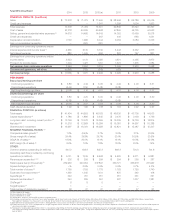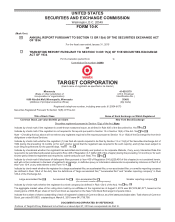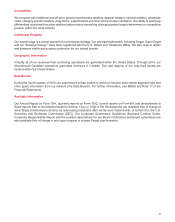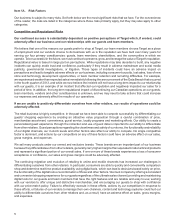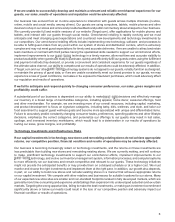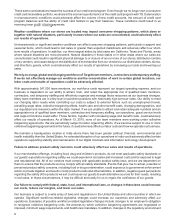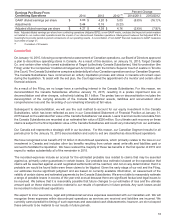Target 2014 Annual Report Download - page 13
Download and view the complete annual report
Please find page 13 of the 2014 Target annual report below. You can navigate through the pages in the report by either clicking on the pages listed below, or by using the keyword search tool below to find specific information within the annual report.
payment card networks, which between them represent a substantial majority of the payment cards potentially impacted
by the Data Breach, have made written claims against us, either directly or through our acquiring banks, and we believe
that it is probable that the fourth major payment card network will also make a claim against us. Collectively, the claims,
investigations and other possible consequences of the Data Breach may have an adverse effect on how we operate
our business and our results of operations. In the future we may be subject to additional investigations and claims of
this sort. We have recorded Data Breach-related expenses that include our estimated probable losses for these matters,
and it is reasonably possible that we may incur a material loss in excess of the amount accrued.
Supply Chain and Third Party Risks
Interruptions in our supply chain or fulfillment network, increased commodity, supply chain and fulfillment
costs, or changes in our relationships with our vendors could adversely affect our gross margins, expenses
and results of operations.
We are dependent on our vendors to supply merchandise to our distribution centers, stores and our guests in a timely
and efficient manner. As we continue to add fulfillment capabilities or pursue strategies with different fulfillment
requirements, our fulfillment network becomes increasingly complex and operating it becomes more challenging. If
our fulfillment network does not operate properly or if a vendor fails to deliver on its commitments, whether due to
financial difficulties or other reasons, we could experience merchandise out-of-stocks, delivery delays or increased
delivery costs that could lead to lost sales and decreased guest confidence, and adversely affect our results of
operations.
In addition, a large portion of our merchandise is sourced, directly or indirectly, from outside the United States, with
China as our single largest source. Political or financial instability, trade restrictions, the outbreak of pandemics, labor
unrest, transport capacity and costs, port security, weather conditions, natural disasters or other events that could slow
or disrupt port activities and affect foreign trade are beyond our control and could disrupt our supply of merchandise
and/or adversely affect our results of operations. For example, the labor disputes impacting the ports on the west coast
of the U.S. that began in 2014 have caused us to make alternative arrangements to continue the flow of inventory,
and if these disputes recur or worsen, it may have a material impact on our costs or inventory supply. Changes in the
costs of procuring commodities used in our merchandise or the costs related to our supply chain, including vendor
costs, labor, fuel, tariffs, currency exchange rates and supply chain transparency initiatives, could have an adverse
effect on gross margins, expenses and results of operations. Changes in our relationships with our vendors also have
the potential to increase our expenses and adversely affect results of operations. We are unable to determine whether
our decision to discontinue our Canadian operations will negatively impact our relationships with vendors that also
supply our U.S. operations in a way that might cause less favorable terms, increased costs, result in less timely and
efficient deliveries, or impact their ability to sell to Target.
A disruption in relationships with third parties who provide us services in connection with certain aspects of
our business could adversely affect our operations.
We rely on third parties to support a variety of business functions, including portions of our technology development
and systems, our digital platforms and distribution network operations, credit and debit card transaction processing,
extensions of credit for our 5% REDcard Rewards loyalty program, and aspects of our clinic and pharmacy operations.
If we are unable to contract with third parties having the specialized skills needed to support those strategies or integrate
their products and services with our business, or if we fail to properly manage those third parties or if they fail to meet
our performance standards and expectations, including with respect to data security, our reputation, sales, and results
of operations could be adversely affected. In addition, we could face increased costs associated with finding replacement
providers or hiring new team members to provide these services in-house.
Legal, Regulatory, Global and Other External Risks
Our earnings are highly susceptible to the state of macroeconomic conditions and consumer confidence in
the United States.
Virtually all of our sales are in the United States, making our results highly dependent on U.S. consumer confidence
and the health of the U.S. economy. In addition, a significant portion of our total sales is derived from stores located
in five states: California, Texas, Florida, Minnesota and Illinois, resulting in further dependence on local economic
conditions in these states. Deterioration in macroeconomic conditions or consumer confidence could negatively affect
our business in many ways, including slowing sales growth or reduction in overall sales, and reducing gross margins.
8



